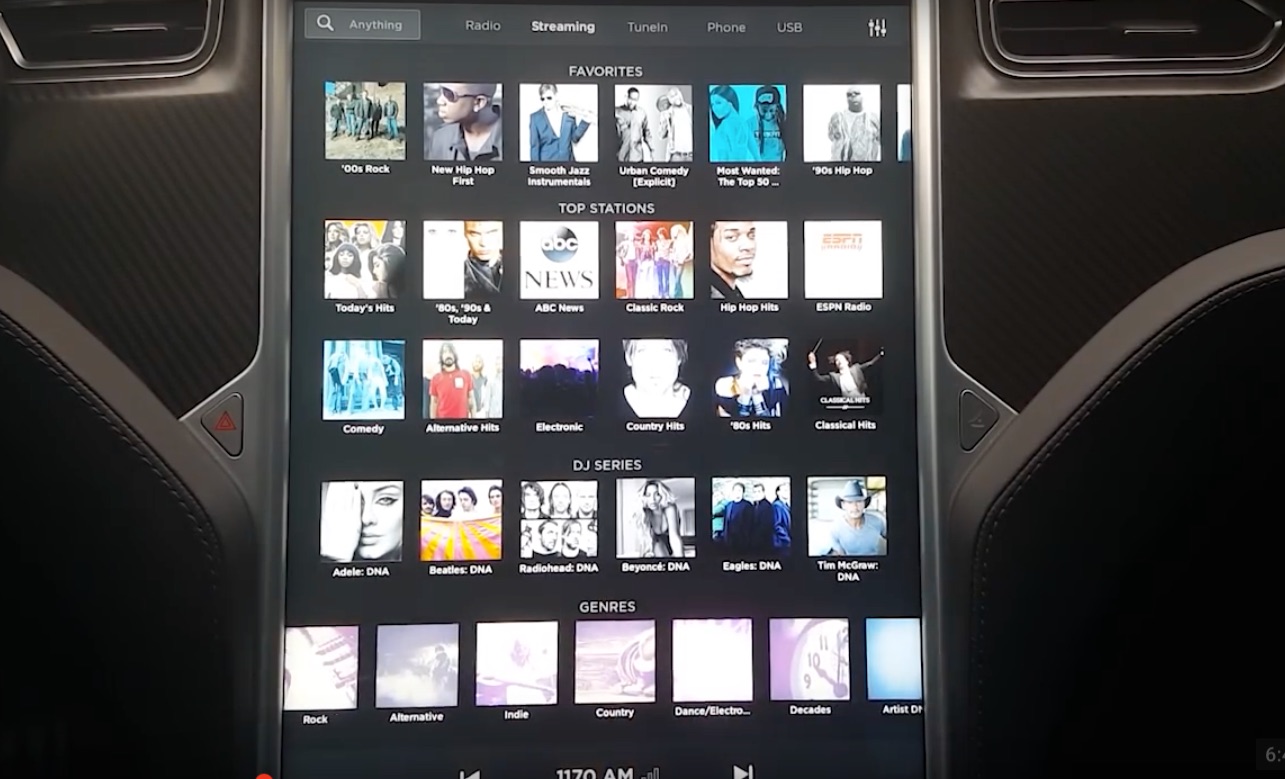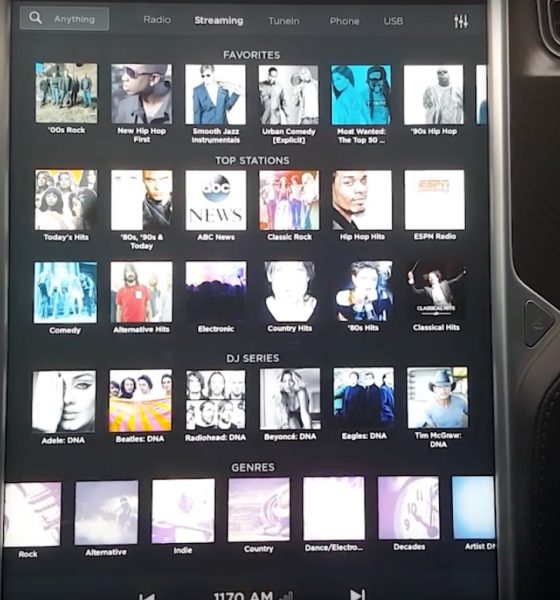

News
Tesla to offer ‘Premium Connectivity’ internet package starting July 1
Tesla will be introducing new cellular connectivity packages for the Model S, Model X, and Model 3 starting July 1. According to the California-based electric car maker, Tesla owners who order their vehicles from July 1 moving forward will have the option to select between a “Premium Connectivity” package and a “Standard Connectivity” package. The new internet packages would be rolled out to all of Tesla’s markets, including Europe, Australia, and Asia.
The Premium Connectivity package includes satellite maps with live traffic visualizations and satellite-view maps. In-car streaming music and media, as well as over-the-air updates via cellular data, are also included in the package, together with other applications and services that are set to be introduced in the future. Full pricing and details are expected to be announced soon, but Tesla expects the internet package to cost roughly $100 per year, or $8.34 per month.
Customers who order a Model S, Model X, or Model 3 with the Premium Interior Package on or after July 1, 2018, will be receiving a year’s worth of Premium Connectivity for free. After the 1-year period is over, owners would be able to select the connectivity package option they prefer. Cars ordered before July 1, including Tesla’s entire fleet today, will not be impacted by the introduction of the new connectivity package options.
Tesla’s Standard Connectivity package includes basic maps and navigation, as well as music and media features through a smartphone’s Bluetooth connection. Over-the-air updates are downloaded through WiFi, though Tesla states that firmware updates related to vehicle safety would be received through cellular at no extra cost. Customers can upgrade to the Premium Connectivity package at any time through the electric cars’ center console.
The main difference between Tesla’s two internet packages lies in live traffic visualization, firmware updates, and in-car streaming. While all vehicles regardless of internet package would feature Tesla’s new and improved Navigation, electric cars with the Standard Connectivity package would not see live traffic visualizations, which are represented by green, orange, and red lines on the vehicle’s maps. The internet browser for the Model S and Model X and music streaming using the car’s cellular data itself would also be unavailable.

Tesla’s improved Navigation, pictured here, would still be accessible to Tesla vehicles with Standard Connectivity packages. [Credit: Black Tesla via YouTube]
Particularly admirable, however, is the fact that all current Teslas on the road today will have the Premium Connectivity package for free for the lifetime of the vehicles. This is a pleasant surprise considering the company’s expectations outlined on its Q4 2013 Shareholder Letter, where Tesla noted that Model S customers would get free data connectivity for four years before the company starts charging for cellular data use.
“To further enhance the driver experience, new Model S customers will now receive free data connectivity and internet radio for four years. As an added benefit to our existing Model S customers, the free four year period starts on January 1, 2014. To be fair to all, in rare cases, a customer may be charged for extreme data use.”
Overall, Tesla’s introduction of its new connectivity packages could be seen as one of the strategies that the company could adopt to achieve its target of hitting profitability by Q3 or Q4 2018. As the size of Tesla’s fleet grows, after all, it becomes more and more costly for the company to provide complimentary cellular internet access to all its vehicles on the road. At around $100 a year or roughly $8.34 per month, Tesla’s Premium Connectivity package is very reasonable, costing less than the price of LTE services for the Apple Watch Series 3, which commands an additional $10 to a mobile phone subscription on AT&T, T-Mobile, and Verizon.

News
Tesla aims to combat common Full Self-Driving problem with new patent
Tesla writes in the patent that its autonomous and semi-autonomous vehicles are heavily reliant on camera systems to navigate and interact with their environment.

Tesla is aiming to combat a common Full Self-Driving problem with a new patent.
One issue with Tesla’s vision-based approach is that sunlight glare can become a troublesome element of everyday travel. Full Self-Driving is certainly an amazing technology, but there are still things Tesla is aiming to figure out with its development.
Unfortunately, it is extremely difficult to get around this issue, and even humans need ways to combat it when they’re driving, as we commonly use sunglasses or sun visors to give us better visibility.
Cameras obviously do not have these ways to fight sunglare, but a new patent Tesla recently had published aims to fight this through a “glare shield.”
Tesla writes in the patent that its autonomous and semi-autonomous vehicles are heavily reliant on camera systems to navigate and interact with their environment.

The ability to see surroundings is crucial for accurate performance, and glare is one element of interference that has yet to be confronted.
Tesla described the patent, which will utilize “a textured surface composed of an array of micro-cones, or cone-shaped formations, which serve to scatter incident light in various directions, thereby reducing glare and improving camera vision.”

The patent was first spotted by Not a Tesla App.
The design of the micro-cones is the first element of the puzzle to fight the excess glare. The patent says they are “optimized in size, angle, and orientation to minimize Total Hemispherical Reflectance (THR) and reflection penalty, enhancing the camera’s ability to accurately interpret visual data.”
Additionally, there is an electromechanical system for dynamic orientation adjustment, which will allow the micro-cones to move based on the angle of external light sources.
This is not the only thing Tesla is mulling to resolve issues with sunlight glare, as it has also worked on two other ways to combat the problem. One thing the company has discussed is a direct photon count.
CEO Elon Musk said during the Q2 Earnings Call:
“We use an approach which is direct photon count. When you see a processed image, so the image that goes from the sort of photon counter — the silicon photon counter — that then goes through a digital signal processor or image signal processor, that’s normally what happens. And then the image that you see looks all washed out, because if you point the camera at the sun, the post-processing of the photon counting washes things out.”
Future Hardware iterations, like Hardware 5 and Hardware 6, could also integrate better solutions for the sunglare issue, such as neutral density filters or heated lenses, aiming to solve glare more effectively.
Elon Musk
Delaware Supreme Court reinstates Elon Musk’s 2018 Tesla CEO pay package
The unanimous decision criticized the prior total rescission as “improper and inequitable,” arguing that it left Musk uncompensated for six years of transformative leadership at Tesla.

The Delaware Supreme Court has overturned a lower court ruling, reinstating Elon Musk’s 2018 compensation package originally valued at $56 billion but now worth approximately $139 billion due to Tesla’s soaring stock price.
The unanimous decision criticized the prior total rescission as “improper and inequitable,” arguing that it left Musk uncompensated for six years of transformative leadership at Tesla. Musk quickly celebrated the outcome on X, stating that he felt “vindicated.” He also shared his gratitude to TSLA shareholders.
Delaware Supreme Court makes a decision
In a 49-page ruling Friday, the Delaware Supreme Court reversed Chancellor Kathaleen McCormick’s 2024 decision that voided the 2018 package over alleged board conflicts and inadequate shareholder disclosures. The high court acknowledged varying views on liability but agreed rescission was excessive, stating it “leaves Musk uncompensated for his time and efforts over a period of six years.”
The 2018 plan granted Musk options on about 304 million shares upon hitting aggressive milestones, all of which were achieved ahead of time. Shareholders overwhelmingly approved it initially in 2018 and ratified it once again in 2024 after the Delaware lower court struck it down. The case against Musk’s 2018 pay package was filed by plaintiff Richard Tornetta, who held just nine shares when the compensation plan was approved.
A hard-fought victory
As noted in a Reuters report, Tesla’s win avoids a potential $26 billion earnings hit from replacing the award at current prices. Tesla, now Texas-incorporated, had hedged with interim plans, including a November 2025 shareholder-approved package potentially worth $878 billion tied to Robotaxi and Optimus goals and other extremely aggressive operational milestones.
The saga surrounding Elon Musk’s 2018 pay package ultimately damaged Delaware’s corporate appeal, prompting a number of high-profile firms, such as Dropbox, Roblox, Trade Desk, and Coinbase, to follow Tesla’s exodus out of the state. What added more fuel to the issue was the fact that Tornetta’s legal team, following the lower court’s 2024 decision, demanded a fee request of more than $5.1 billion worth of TSLA stock, which was equal to an hourly rate of over $200,000.
Delaware Supreme Court Elon Musk 2018 Pay Package by Simon Alvarez
News
Tesla Cybercab tests are going on overdrive with production-ready units
Tesla is ramping its real-world tests of the Cybercab, with multiple sightings of the vehicle being reported across social media this week.

Tesla is ramping its real-world tests of the Cybercab, with multiple sightings of the autonomous two-seater being reported across social media this week. Based on videos of the vehicle that have been shared online, it appears that Cybercab tests are underway across multiple states.
Recent Cybercab sightings
Reports of Cybercab tests have ramped this week, with a vehicle that looked like a production-ready prototype being spotted at Apple’s Visitor Center in California. The vehicle in this sighting was interesting as it was equipped with a steering wheel. The vehicle also featured some changes to the design of its brake lights.
The Cybercab was also filmed testing at the Fremont factory’s test track, which also seemed to involve a vehicle that looked production-ready. This also seemed to be the case for a Cybercab that was spotted in Austin, Texas, which happened to be undergoing real-world tests. Overall, these sightings suggest that Cybercab testing is fully underway, and the vehicle is really moving towards production.
Production design all but finalized?
Recently, a near-production-ready Cybercab was showcased at Tesla’s Santana Row showroom in San Jose. The vehicle was equipped with frameless windows, dual windshield wipers, powered butterfly door struts, an extended front splitter, an updated lightbar, new wheel covers, and a license plate bracket. Interior updates include redesigned dash/door panels, refined seats with center cupholders, updated carpet, and what appeared to be improved legroom.
There seems to be a pretty good chance that the Cybercab’s design has been all but finalized, at least considering Elon Musk’s comments at the 2025 Annual Shareholder Meeting. During the event, Musk confirmed that the vehicle will enter production around April 2026, and its production targets will be quite ambitious.








